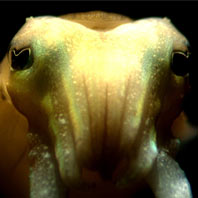TV Program Description
Original PBS Broadcast Date: April 3, 2007
Join NOVA on a voyage beneath the waves, where you'll discover
a bizarre, alien-like creature like no other. It's an animal
with eight sucker-covered arms growing out of its head, three
hearts pumping its blue-green blood, and a doughnut-shaped
brain. It has the ability to change its color and shape to
blend in with seaweed and rocks, and it has a knack for
switching on electrifying light shows that dazzle its prey.
Perhaps most surprising of all, this animal is quite
intelligent, with a highly complex brain. In this program,
underwater cameras capture the extraordinary, transformative
powers of the cuttlefish.
Not a fish at all, the cuttlefish is a cousin to the more
well-known octopus and squid. Together, they are a part of the
class of marine mollusks (soft-bodied animals without a spine)
called cephalopods, or "head-footers." But while cuttlefish
are lesser known, they are very clever. In fact, they have one
of the biggest brain-to-body ratios of all invertebrates.
They also have a special talent. Mark Norman, a marine
biologist and senior curator from Australia's Museum Victoria,
is one of the film's featured experts and has studied
cuttlefish for over 20 years. According to Norman, it is the
cuttlefish's amazing capacity to rapidly change its color,
pattern, and shape that makes this creature so intriguing. By
pushing up different parts of its skin, it can camouflage
itself against the reef. And with the striking displays of
color and light on its skin, it can appear like an alien
spaceship hovering in the water, intimidating mating rivals or
even hypnotizing a tasty morsel like a crab before attacking
it (see
Quick Change Artists).
The program introduces viewers to the elusive Broadband
cuttlefish, known for its particularly flashy light shows. By
presenting the cuttlefish with various lures, including small
crabs and a toy lobster, marine biologists seek to find out
what makes this cuttlefish put on its amazing light displays,
as well as whether it is intelligent enough to quickly
understand if a lure is unattainable. (It seems to be: it only
takes a few tries for a cuttlefish to lose interest after
determining that a crab inside a glass jar cannot be caught.)
So how do cuttlefish develop their visual pyrotechnics? At the
Marine Biological Laboratory in Massachusetts, Roger Hanlon
shows viewers how it's done. The secret, he explains, lies in
specialized layers of skin cells. The top layer features
pigmented cells that provide most of the yellow, red, and
brown patterning. By pulling out and pushing in different
muscles, the cuttlefish can display various groups of
pigmented cells. A deeper layer of iridescent reflecting cells
in blue, green, red, and pink, as well as a white base,
complete the palette.
"Kings of Camouflage" also showcases several other kinds of
cuttlefish, including a tiny species called the Flamboyant
cuttlefish. The size of an egg, it walks on the seafloor
rather than swims. And then there are the amazing Giant
Australian cuttlefish, which come together to breed off the
south coast of Australia every autumn.
One of the most amazing displays of the Giant cuttlefish
proves that they have plenty of brains and not just brawn.
Small males, who cannot compete physically with their larger
counterparts, have developed a cunning way to sneak in and
mate with their desired female, by "dressing" as a female
cuttlefish. They pull in their arms, change their colors to a
mottled pattern, and glide by the larger males. Once this
female mimic swims underneath and finds the female, he often
as not successfully mates with her. (See
Mating Trickery for
other animals that practice crafty courtship.)
Cuttlefish go through only one of these mating
cycles—they burn bright and die young, usually between
18 months and two years of age. With such a short life span,
it is even more surprising that they are so intelligent. Jean
Boal of Millersville University in Pennsylvania shows viewers
how much, and how fast, cuttlefish can learn (see her
interview). Boal
creates a special enclosure to assess the cuttlefish's ability
to figure out the right escape route. As it turns out, her
cuttlefish are able to learn the rules of finding the
open exit, and repeat their success trial after
trial—yet another example of the smarts of this
beguiling creature.

Program Transcript
Program Credits

